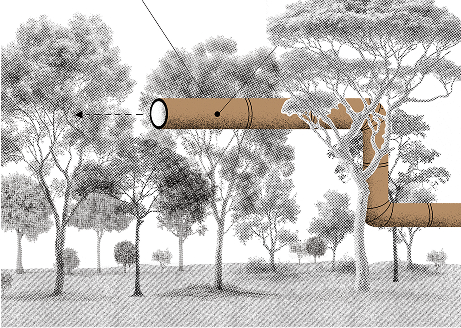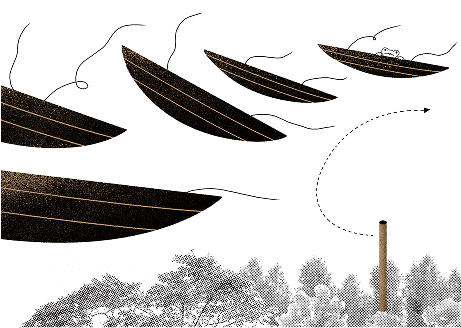Commissioner
Exhibition Overview
Little Toad, Little Toad: Unbuilding Pavilion
The Korean Pavilion
19th International Architecture Exhibition –
La Biennale di Venezia
19th International Architecture Exhibition –
La Biennale di Venezia
May 10 – November 23, 2025
Artistic Director
CAC (Curating Architecture Collective: Chung
Dahyoung, Kim Heejung, Jung Sungkyu)
Architects/Artists
Kim Hyunjong (ATELIER KHJ)
Lee Dammy (Flora and Fauna)
Heechan Park (Studio Heech)
Young Yena (Plastique Fantastique)
Lee Dammy (Flora and Fauna)
Heechan Park (Studio Heech)
Young Yena (Plastique Fantastique)
Commissioner
Arts Council Korea
Curatorial Statement
Little toad, little toad / I will give you
an old house /
In return for a new house
In return for a new house
두껍아 두껍아 / 헌 집 줄게 / 새 집 다오
Dukkeoba, dukkeoba / Heon jip julge / Sae jip
dao
Little toad, little toad / Go fetch some
water /
I will build your house
I will build your house
두껍아 두껍아 / 물 길어 오너라 / 너희 집 지어
줄게
Dukkeoba, dukkeoba / Mul gireo oneora /
Neohui jip jieo julge
Neohui jip jieo julge
Little toad, little toad / Your house is on
fire /
Wend your way here with a pitchfork
Wend your way here with a pitchfork
두껍아 두껍아 / 너희 집에 불났다 /
쇠고랑 가지고 뚤레뚤레 오너라
쇠고랑 가지고 뚤레뚤레 오너라
Dukkeoba, dukkeoba / Neohui jibe bullatda /
Soegorang gajigo ttullettulle oneora
Soegorang gajigo ttullettulle oneora
The Korean Pavilion at the 19th International
Architecture Exhibition, La Biennale di Venezia
takes the architecture of the pavilion itself as its
subject of exploration, commemorating the 30th
anniversary of its establishment. The exhibition
reexamines the meaning of the pavilion, a space that
has hosted numerous artists and works as a “house”
of exhibitions. By revisiting its founding
motivations past trajectory, the exhibition seeks
out future possibilities and sustainability of the
Korean Pavilion. Little Toad, Little Toad: Unbuilding Pavilion aims to reinterpret and rewrite the pavilion, with
a viewpoint that sees the pavilion not as a white cube
or neutral exhibition space, but as an organic entity
with multilayered meanings. The exhibition is composed
of research and visual works that provoke critical reflection
on this line of inquiry.
The title Little Toad, Little Toad—borrowed
from a Korean folk song for children—serves as a
metaphorical framework for this exploration. ‘Little
Toad, Little Toad(Dukkeoba, Dukkeoba)’ is a
house-building song sung during children’s mud play
that calls to mind a grotto, which can be considered
as a primitive type of folly. The fabular lyrics are
filled with references to house and shelter: the
relationship between the “old house(heon jip)” and the “new house(sae jip)” within the
song mirrors the temporal division of the pavilion’s
past and future at this 30-year mark. The crisis of
a “house on fire(jibe bullatda)” invites
reflection on the dilemmas faced by the pavilion and
encourages us to situate La Biennale within the
broader global discourse on climate change and
sustainability.
The unseen narrator of this exhibition, the toad, is
a mythical being symbolizing transformation and
regeneration not only in Korea but across both
Eastern and Western cultures. It is evoked to
reawaken the ancient shared heritage of the
Giardini: the trees, the land, the sea, and the sky.
Reexamining the history and status of the Korean
Pavilion within this interconnected environment
opens up inquiries into the cultural and political
contexts of national pavilions. This naturally
evolves into imagining the transformation and
regeneration that lie ahead of La Biennale itself.
Exhibition Layout


The exhibition is structured around two main
frameworks. The first involves caring for the Korean
Pavilion from both spatial and temporal
perspectives. The goal was to illuminate the
architectural origins of the pavilion and reveal the
stories embedded within it. Akin to affixing a
nameplate to a house or captions to artworks, the
curatorial team has installed plaques throughout the
structure, identifying the architecture. Captions
were provided not only for basic architectural
information—such as who designed the pavilion and
when it was completed—but also for the surrounding
trees that played a foundational role in shaping its
form. Within the exhibition space, previously rarely
shown representations of the underground and rooftop
levels are presented through plans and sections, as
well as the layout with surrounding vegetation.
These representations illustrate the interconnected
and reciprocal relationships that run through the
structure. A documentation video, compiled from the
materials found in various archives, captures the
past, present, and future of the pavilion. Various
entities, including the toad from the title, appear
in the video to offer the narratives of this place
from multiple perspectives.
The second element of the exhibition is the
commissioned works by participating artists. Four
architects are invited by the curatorial team to
read the archive and engage in a process of
unbuilding and reassembling the pavilion in order to
reveal its overlooked values and meanings. Rather
than centering on questions of national identity—an
issue historically central to the Korean
Pavilion—the invited artists shift their focus to
the shared physical foundations that both
conditioned and motivated its establishment. The
commissioned works do not physically alter the
structure; instead, they operate as speculative
narratives, awakening and amplifying the existence
of the pavilion.
© Jung Jinho
Credits
Curators
CAC (Chung Dahyoung,
Kim Heejung, Jung Sungkyu)
Kim Heejung, Jung Sungkyu)
Architects/Artists
Kim Hyunjong
Heechan Park
Young Yena
Lee Dammy
Heechan Park
Young Yena
Lee Dammy
Assistant Curator
Kwak Seung-Chan
On-site Manager/
Construction Supervisor
Construction Supervisor
Kim Eun Jeong
Spatial Design
Kim Giseok
Graphic Design
Kim Yuna
Videography
Baek Yunsuk
Illustration
Jung Jinho
Catalog Editor
Park Junghyun
Kwak Seung-Chan
Kwak Seung-Chan
Catalog Designer
O Hezin
Catalog Contributors
Chun Jinyoung
Chung Dahyoung
Jung Sungkyu
Alice S. Kim
Kim Heejung
Kim Hyunjong
Kwak Seung-Chan
Lee Dammy
Heechan Park
Christian Schweitzer
Song Ryul
Léa-Catherine Szacka
Young Yena
Chung Dahyoung
Jung Sungkyu
Alice S. Kim
Kim Heejung
Kim Hyunjong
Kwak Seung-Chan
Lee Dammy
Heechan Park
Christian Schweitzer
Song Ryul
Léa-Catherine Szacka
Young Yena
Catalog Publisher
Propaganda
Research
Lee Jungwon
English Copy Editor
Alice S. Kim
Transportation
ARTrans
PR
MAG PR & Image
Exhibition Photos
Choi Yongjoon
Web Developer
DEERSTEP
Arts Council Korea
Byoung Gug Choung
(Chairperson)
Song Si Kyeong
(Director of General Secretariat)
Jade Keunhye Lim
Hyeju Choi
Sunhee Yeo
Ji Yeon Yu
Haebin Lee
(ARKO Art Center)
Choi Jung Eun
(Arts Advocacy Center)
(Chairperson)
Song Si Kyeong
(Director of General Secretariat)
Jade Keunhye Lim
Hyeju Choi
Sunhee Yeo
Ji Yeon Yu
Haebin Lee
(ARKO Art Center)
Choi Jung Eun
(Arts Advocacy Center)
Partner
IKEA Korea
Sponsorship
Samsung Foundation of Culture
JOOSUNG DESIGNLAB
JUNGLIM ARCHITECTURE
PNL Co., Ltd. / KIM, SEOK WOO
HAEAHN Architecture, Inc
Gansam Co.,Ltd
SPACE GROUP
THE_SYSTEM LAB
DUOMO
J.archiv
JOOSUNG DESIGNLAB
JUNGLIM ARCHITECTURE
PNL Co., Ltd. / KIM, SEOK WOO
HAEAHN Architecture, Inc
Gansam Co.,Ltd
SPACE GROUP
THE_SYSTEM LAB
DUOMO
J.archiv
Technical Support
LG OLED AI
LG StanbyME
LG StanbyME
Scenography Supported by
VOLA
Collaborator
LUSH
Supporters
BCHO Architects Associates
ONE O ONE architects
Harper’s BAZAAR Korea
WOOYOUNGMI
ONE O ONE architects
Harper’s BAZAAR Korea
WOOYOUNGMI
Artists Supported by
STRX/UPPERHOUSE
Luna&Company
KM Beam
Helinox
Luna&Company
KM Beam
Helinox
Paper Supported by
Hansol Paper
Special Thanks to
ARKO Arts Archive
Shin Haewon
Chun Jinyoung
Cho Byoungsoo
Choi Wook
Franco Mancuso
Shin Haewon
Chun Jinyoung
Cho Byoungsoo
Choi Wook
Franco Mancuso
Associated Institution
Seoul Metropolitan Government
(Seoul Biennale of Architecture and Urbanism)
(Seoul Biennale of Architecture and Urbanism)









